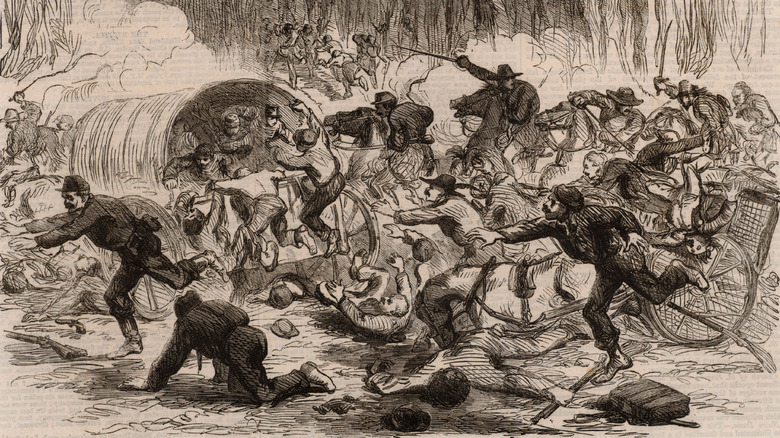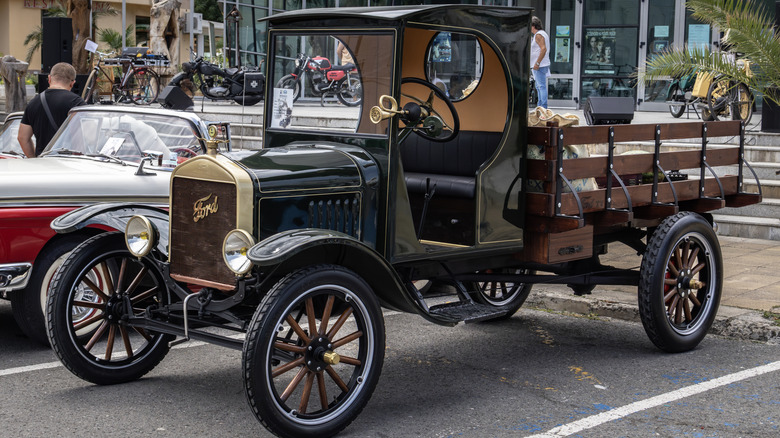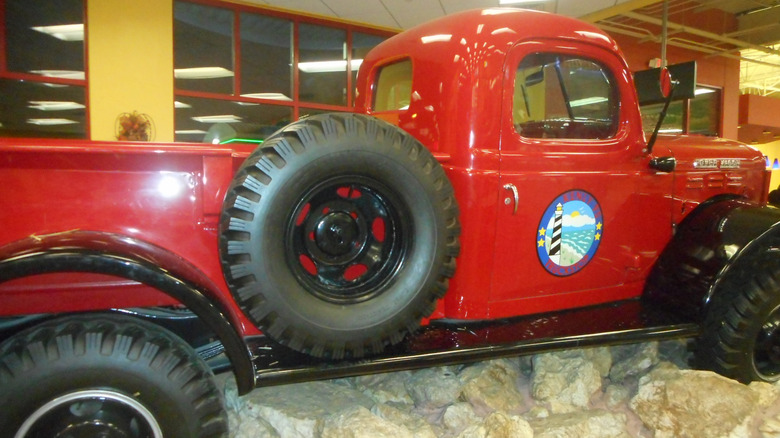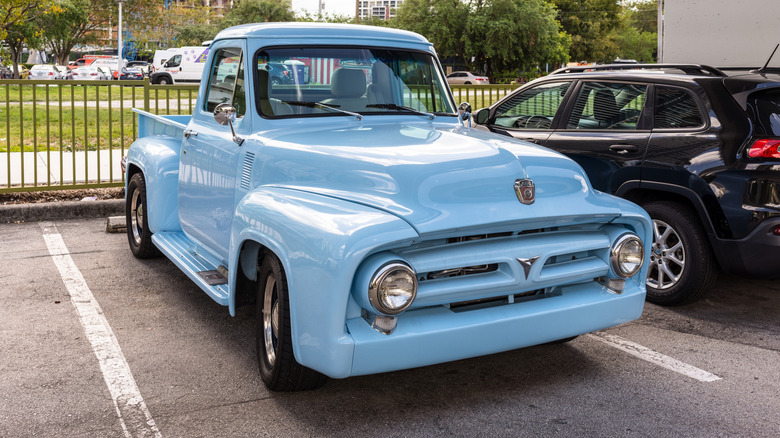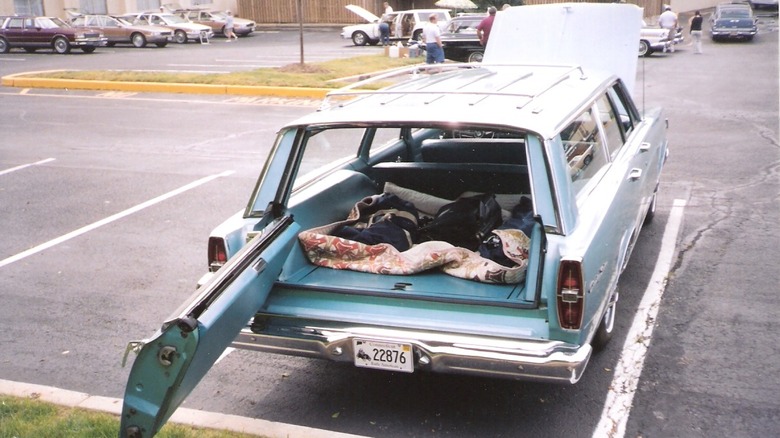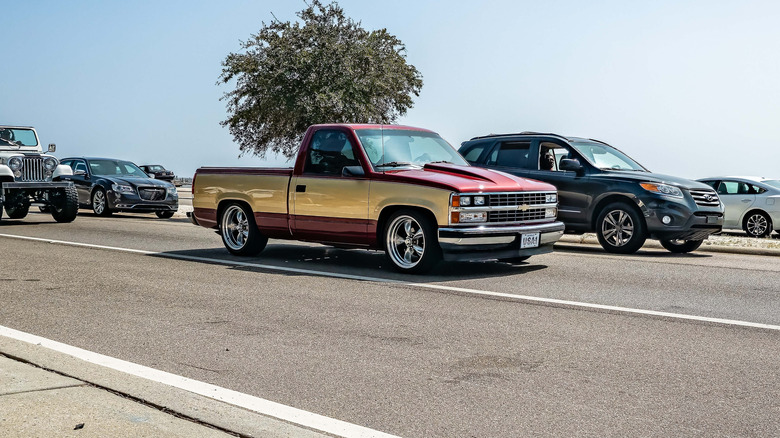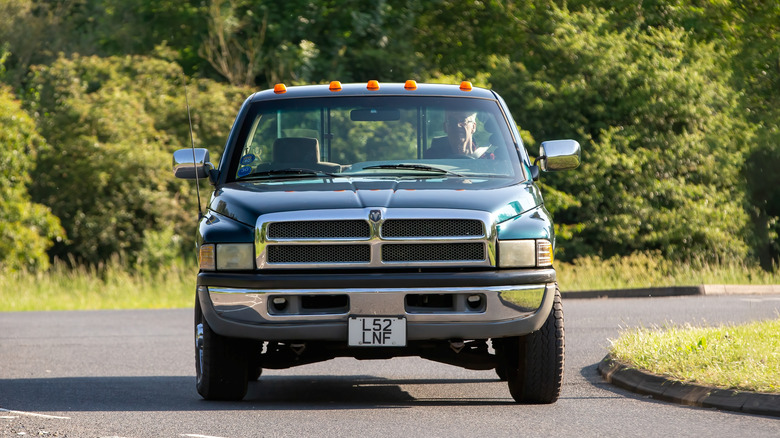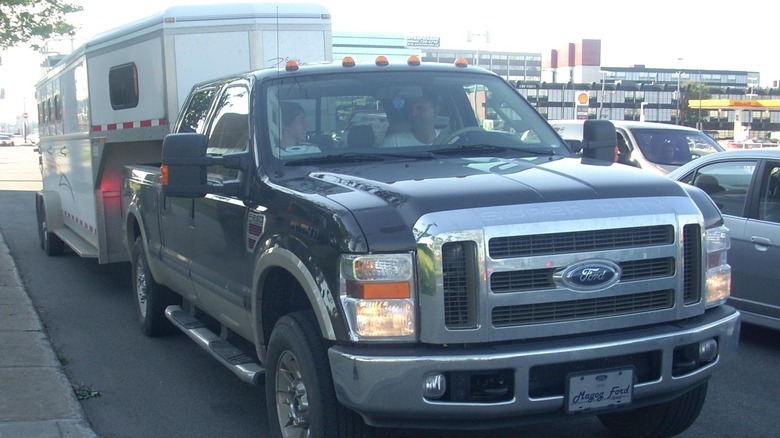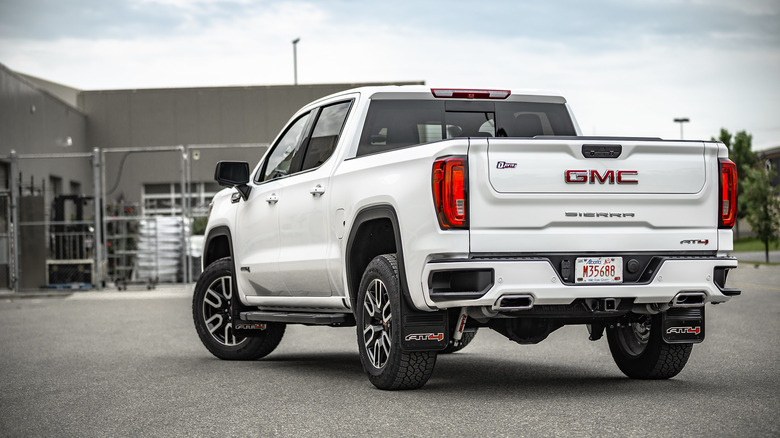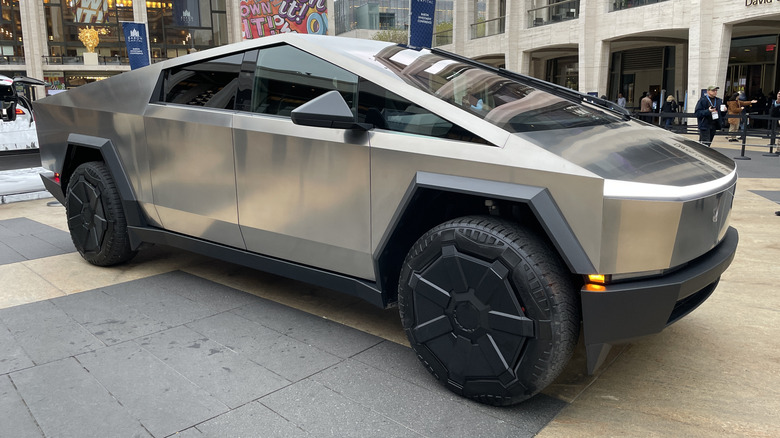How The Tailgate Became A Symbol Of American Truck Culture
Besides the blue, red, and white hues of the star-spangled banner itself, some items have grown to become symbols of America. These symbols vary in nature, from the bald eagle to a particularly juicy cheeseburger. Among said bastions of American culture, pickup trucks firmly hold a seat at the table -– a longstanding vehicle of choice for the average American.
These trucks typically come equipped with tailgates. With technological advancements and design changes, the picture of what tailgates are capable of continues to morph. However, at its nucleus, the tailgate exists to hold cargo in the truck bed and prevent loaded objects from sliding off. This core utilitarian vision formed the blueprints of the very first tailgate truck models back in the 1920s. As the vehicle type grew in popularity over the years -– eventually reaching its current near-ubiquitous status -– the tailgate would eventually be interwoven into the fabric of truck culture (and America by extension).
Tailgates didn't attain this lofty status on American roads by remaining one-dimensional. Their greatest strength lies in utility, and leading manufacturers like Ford led the charge to gradually redesign tailgate functions. Although these designs were originally engineered with cargo security in mind, the tailgate has since advanced to accommodate high-tech features and multi-functional uses. There's a whole history to the development of tailgate design, but here's how they've been enmeshed in truck culture over the years.
The tailgate's American history has roots in the Civil War
While the first tailgate vehicles may have started rolling out in the mid-1920s, a portion of the vehicle's inspiration can be traced back to the Civil War, where the concept and enduring tradition of tailgating began on the American scene. Union commander John Tidball gave an account of bystanders watching the First Battle of Bull Run (which is also referred to as the "picnic battle") "in carts loaded with pies and other edibles."
In the following decades, tailgating would take root as a cultural phenomenon with the expansion of college football. For example, the 1906 Harvard vs. Yale game reported fans snacking in pre-match picnics, laying tablecloths on the floor outside their cars. The exact timeline when the "tailgating" moniker for this tradition was formed is unclear, but the origin is likely derived from tailgate trucks.
With the arrival of station wagons and trucks in the 1920s, the tailgate provided an improvised stand for eventgoers to dine on. As such, tailgates evolved beyond mere safeguards for cargo stationed in truck beds; they became a symbol of the free American spirit -– a status that persists to date.
The 1920s: the start of America's love affair with the tailgate
The journey of tailgate trucks from humble beginnings to multiterrain superstars began a few years before the Great Depression, with Ford debuting the first factory-assembled pickup in 1925. Dubbed the Model TT, it came fitted with a cargo box and an adjustable tailgate. The seemingly minute manufacturing detail of adding a hinge to the flat metal panel paved the way for easier inventory loading and removal from the truck bed. It proved to be a stroke of genius, as the Model TT would go on to sell 300,000 units in its first year.
By 1929, the Ford Model A took the mantle of furthering tailgate truck technology from the TT pioneer. Officially recognized as the manufacturer's first station wagon, the tailgate vehicular archetype had successfully spread its influence and delved into a separate branch of motoring. Although this trim curiously elected to omit a rear window from its features, it supported the emerging trend of tailgates appearing on highways.
The 1940s: the birth of the four-wheel drive
The '30s were rather uneventful in terms of tailgate innovations. The 1940s were a different story. With ingenuity born of the necessity arising from the Second World War, pickup trucks began to transition to four-wheel-drive technology.
The first of this vehicular class was the 1946 Dodge Power Wagon, with Willys-Overland Motors following close behind with the Jeep pickup truck in 1947. Dodge marketed the innovation at the time as "the truck that needs no roads" -– effectively pioneering the off-roading versatility and toughness that still defines what makes a good American truck. This expansion in utility allowed the Dodge to essentially double as a tractor, with advertisements marketing the potential of accessories like hydraulic pumps to aid in farm tasks.
While these advancements broadened the horizon of tailgate trucks in terms of usage options, the Ford F-Series launch in 1948 tackled another problem for the archetype. The F-1 came outfitted with a tailgate that was adorned by tapered edges and anti-rattle drop chains. These chains allowed the tailgate to swing all the way down, expanding the cargo bed to an advertised 45 cubic feet of load space. In terms of cultural influence, the impact of the 1940s cannot be overstated, with the 1946 Hudson Super Six Pickup appearing as a tritagonist in the "Cars" movie franchise.
The 1950s: style meets performance in tailgate trucks
The '50s would see the tailgate pickup truck continuing to expand its sphere of influence on the growing American automotive industry. The 1952 Volkswagen Transporter ushered in a relatively new era of forward-controlled pickups; a trend that would be adopted by the likes of the Jeep FC-150 in 1956 and later in the early '60s by the Chevrolet Corvair Pickup.
Ford advanced into the second generation of its pickup trims during this age, with the 1953 Ford F-100 phasing out the F-1 pioneer. This model, alongside the F-250 and F-350, represented the manufacturer's transition into a commercial-friendly market. While features such as armrests brought a new sheen of comfort to the vehicle, the switch from flathead engines to overhead valve engines (OHVs) played an equally instrumental role in catapulting Ford's sales by 40% in 1953.
The 1953 Ford F-100 sowed the seeds of a hybrid blueprint of style and performance, and Chevrolet would respond in 1955 with the Cameo Carrier. To meet up with aesthetic standards, Chevrolet used fiberglass to reinforce the truck bed and also applied the material to the tailgate. Outfitted with an automatic transmission that was more common in cars at the time, the Cameo Carrier represented a harbinger of things to come for tailgate trucks– a gradual evolution into a marriage of comfort and grit.
The 1960s: tailgates begin to change structure
The core design of the tailgate had barely changed in the years since its introduction except for a few aesthetic and mechanical tweaks, but more tangible evolution would come in the 1960s. Ford's 1960 Falcon wagon led the way, converting the previously rudimentary tailgate into a single-piece with a retractable rear window. 1961 saw the removal of the crude steel chains traditionally used to secure the metal piece, with manufacturers preferring instant-action latches. This detail allowed for one-handed operation and increased tailgate width by 13 inches -– translating to even more storage in the truck bed.
1966 brought perhaps the most significant change to the tailgate piece, with Ford and Farlaine station wagons rolling out the Magic Doorgate. From the first designs of the tailgate, the metal accessory had only ever traveled along one plane: up or down. The Magic Doorgate changed that, opening downward like a regular tailgate or outward like a door. In 1969, this capability evolved to a three-way phenomenon through the option to extend the tailgate along with the rear window.
The '70s and '80s: converting tailgate trucks to hybrid work-play machines
By 1971, General Motors would further advance tailgate utility with the introduction of the clamshell tailgate in its Buick Estate wagons. Where the Magic Doorgate could swing either down or out, the clamshell engineered a design where the tailgate could stay out of sight under the cargo bed. Ford went on to develop its own removable tailgate in 1980, although theft concerns necessitated a redesign with locking mechanisms.
Chevrolet would roll out the fourth-generation of the C/K trim in the mid-70s (with the top-level christened Silverado), but the 1988 model in particular is regarded as one of the greatest trucks of all time. Equipped with comfy interior fittings and advanced tech like anti-lock brakes, the 1988-98 Silverado line would grow into a cultural icon, becoming closely related to Bob Seger's legendary "Like A Rock" hit after a series of ad campaigns. In Chevrolet's bid to convince customers of the truck's sturdiness in the ads, tailgates once again found themselves woven into the fabric of American culture -– this time in music.
The '90s: the era of wholesale changes to the pickup truck
Continuing the evolving trend from the 1980s, manufacturers began to churn out models with equal focus on style and performance in the '90s. This was the breakout era of muscle trucks. The 1990 Silverado 454 SS effectively kick-started the muscle truck dominance by bringing big-block engines back to relevance, with its V8 engine good for 230 hp. The GMC Syclone would build on this number in 1991, sporting a turbocharged V6 that could produce 280 hp and go from 0-60 mph in just over 4 seconds.
Beyond performance metrics, the '90s would also see significant design changes come to tailgate trucks — both on the inside and outside. Passenger comfort became a priority, with models such as the 1998 Toyota Hilux Extra Cab offering a generous 42.8 inches of front legroom. Features like air conditioning and entertainment systems also appeared in select truck trims around the same time, with the Chevy Silverado and Toyota's T100 among the trailblazers in this area.
With the numerous upgrades to interior design and performance, tailgate trucks needed a cosmetic facelift to match. The boxy shape of the front end was a staple of the early '90s, but the 1994 Dodge Ram presented a daring new outlook. Taking inspiration from big rigs of the time, the Dodge Ram changed the game by dropping its headlights from their standard position level with the top of the grills.
The 2000s: reimagining the tailgate
The tailgate itself would wait till the turn of the century to get its next round of major design tweaks. In 2003, the Lincoln Navigator offered an optional power liftgate, and Ford's F-Series pickups followed in 2004 with Tailgate Assist -– a mechanism that transferred much of the tailgate's weight to built-in torsion bars; facilitating easier manipulation and handling.
More incremental changes such as quick-release tailgates followed, and the 2006 Honda Ridgeline included a modern remaster of Ford's Magic Doorgate from the '60s. Where Ford's version catered to the County Esquire station wagon, the Honda Ridgeline's "Dual Action" design was the first pickup truck implementation; a visionary approach that would earn the Ridgeline trim multiple accolades.
However, the most significant addition of the era would come in the form of the 2008 Ford Super Duty's optional tailgate step. This evolution came with a stowable bed extender, which allowed drivers to haul payloads with the tailgate hanging down. This particular addition to the tailgate's changing landscape of uses is one of the most common features of today's multi-function tailgate trucks. In this manner, tailgates grew beyond the confines of their original securing purpose.
The 2010s: the tech-ification of the tailgate
The 2010s would further redefine the textbook outlook of tailgates. Technological features came to the fore and bolstered the metal with an array of handy functions. The Ford Escape added hands-free gesture-based technology to automatically open the liftgate (most commonly by swiping the foot under the bumper). More automation followed in 2015 with the power tailgate lock and key-controlled tailgate drop functions. While these additions changed the game in terms of quality-of-life features, Ram and General Motors had more innovative ideas up their sleeves.
2019 saw General Motors construct one of the most tech-loaded tailgates in the business. Given the "MultiPro" moniker for the GMC Sierra 1500, the tailgate comes divided into two horizontal parts. This design allows multiple creative configurations. There's the standard tailgate dropdown that increases truck bed length. The inner wall of the upper portion can also be raised to serve as a tailgate in this scenario -– a handy load stop setting for securing taller cargo. That's not all the utility in the "standard" package; this improvised tailgate can again be folded if a workstation is needed.
General Motors also incorporated the tailgate step in this design. Beyond the functional versatility, infotainment systems also adorned the new tailgate, with the manufacturer adding speakers to the structure. Ram followed this design trail with its own version in the Ram 1500: the multifunction tailgate. This blueprint split the tailgate in a 60-40 ratio, giving more access to the truck bed.
Modern day: the tailgate still pulling strong
Although the 2010s can be viewed as the peak of the tailgate's technological advancements, modern-day trucks are still locating margins for improvement in utility and convenience. Ford, for instance, rolled out a power tailgate in the 2021 F-150, outfitting it with a multi-function work surface. Besides this practicality, the manufacturer added tie-down hooks to the tailgate that double as bottle openers.
This evolving culture of convenience has manifested in various forms, most recently in 2023 with Ford's answer to GM and Ram's multifaceted tailgates. The Pro Access tailgate made its debut amidst a bevy of exciting features in the F-150 Tremor models, offering selling points of reduced walking distance to the tailgate handle by opening from the driver's side and swing door openings of 37, 70, and 100 degrees. This configuration gives access to the truck bed even when towing payloads, complete with an extended bumper step and an optional retractable tailgate for extra climbing assistance.
All these innovations have pushed the visibility of pickup trucks even further -– the percentage share of new vehicle sales in America for the pickup jumped from 16.8% in 2016 to 20.5% in 2022. In fact, pickup trucks held four positions in the top 10 best-selling cars in America in 2024. As technology advances, it's probably not a stretch to expect that number to climb even more in the coming years.
Cybertrucks and the future of the tailgate
As competitive as the pickup category is, it's heading into uncharted territory with EV manufacturers. Using Tesla as a case study, the Cybertruck model may be one of the most divisive vehicles in automobile history, but it represents a futuristic glimpse into the next possible evolution of the tailgate market.
Equipped with power outlets to plug in devices from TVs to speakers, Tesla offers an infotainment system that keeps up with modern demands. In terms of modifications to the tailgate itself, the manufacturer includes an optional ramp, an integrated bed cover, and a tailgate shield to protect its design while hauling payloads. Beyond physical additions, Tesla also brings a host of quality-of-life upgrades to the table that rivals the lineup of traditional pickups. For starters, Cybertruck tailgates can be controlled remotely via a smartphone app. The main convenience advantage here is that it can be manipulated from a distance.
Additionally, the Cybertruck's tailgate can be adjusted to different opening heights, which allows the metal to remain partially open in the interest of accommodating long cargo. The Cybertruck evolution, although currently unfavorable in the court of public opinion, speaks to the importance of the tailgate and its symbolism; it has thrived throughout its 100-plus-year history, and it doesn't seem to be in danger of going anywhere any time soon.

